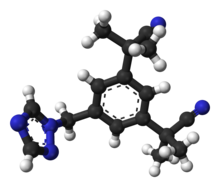Anastrozole
 | |
 | |
| Clinical data | |
|---|---|
| Routes of administration | oral |
| ATC code | |
| Legal status | |
| Legal status |
|
| Pharmacokinetic data | |
| Bioavailability | 83-85% |
| Protein binding | 40% |
| Metabolism | 85% hepatic |
| Elimination half-life | 72 hours |
| Excretion | 11% renal |
| Identifiers | |
| |
| CAS Number | |
| PubChem CID | |
| DrugBank | |
| ChemSpider | |
| CompTox Dashboard (EPA) | |
| ECHA InfoCard | 100.129.723 |
| Chemical and physical data | |
| Formula | C17H19N5 |
| Molar mass | 293.366 g/mol g·mol−1 |
| 3D model (JSmol) | |
| |
| (verify) | |
Anastrozole (INN, trade name Arimidex, AstraZeneca) is a drug used to treat breast cancer after surgery and for metastases in post-menopausal women.
Anastrozole is an aromatase inhibitor, which means that it interrupts a critical step in the body's synthesis of estrogen. Some breast cancer cells require estrogen to grow, and eliminating estrogen suppresses their growth.
Annual sales approx $2.2bn. Patent expires 2010 in the US[1]; however, the generic form is available in some other markets.
Clinical trials
The ATAC (Arimidex, Tamoxifen, Alone or in Combination) trial represents a long-term follow-up study of 9366 women with localized breast cancer who received either anastrozole, tamoxifen, or both.[2] After more than 5 years the group that received anastrozole had significantly better clinical results than the tamoxifen group. The trial suggested that anastrozole is the preferred medical therapy for postmenopausal women with localized breast cancer that is estrogen receptor (ER) positive.
Another study found that the risk of recurrence was reduced 40% (with some risk of bone fracture) and that ER negative patients also benefited from switching to Arimidex.[3]
Mechanism of Action
Anastrozole inhibits the enzyme aromatase, which is responsible for converting androgens to estrogens. Anastrozole binds reversibly to the aromatase enzyme through competitive inhibition.
Elevated levels of estrogens may increase the severity of breast cancer, as sex hormones can cause hyperplasia and differentiation at estrogen receptor sites.
Side effects
Bone weakness : Women who switched to Arimidex (after two years on tamoxifen) reported twice as many fractures as those who continued to take tamoxifen (2.1% compared to 1%).[3]
Bisphosphonates are sometimes prescribed to prevent the osteoporosis induced by aromatase inhibitors but have another serious side effect, osteonecrosis of the jaws. Since statins have a bone strengthening effect [4], combining a statin with an aromatase inhibitor may avoid both fractures and possible cardiovascular risks [5] without jaw osteonecrosis.[6] In one study of women with breast cancer taking anastrozole, statin use was associated with a 38% reduced fracture risk, or approximately the equivalent of 10 mg Fosamax daily.[7]
Usage for men
While officially indicated for women, this drug has proven effective in the off-label use of reducing estrogens (in particular and more importantly, estradiol) in men. Excess estradiol in men can cause benign prostatic hyperplasia, gynecomastia, and symptoms of hypogonadism. Some athletes and body builders will also use anastrozole as a part of their steroid cycle to reduce and prevent symptoms of excess estrogens; in particular, gynecomastia and water retention.
Study data currently suggests that dosages of 0.5 mg to 1 mg a day reduce serum estradiol by about 50% in men, which differs from the typical reduction in postmenopausal women. However the reduction may be different for men with grossly elevated estradiol (clinical data is currently lacking).
Usage for children
This drug is frequently used in the treatment of children with growth disorder to stop or slow the onset of puberty. The cause of the growth disorder is through hormones which may trigger the early onset of puberty. At the onset of puberty the bone growth plates begin to close. This can occur in children as young as 5 years old, so for children severely behind in growth, the opportunity for increased growth is diminished. Arimidex is shown to slow or stop this process.
References
- ^ Details for Anastrozole
- ^ Howell A, Cuzick J, Baum M; et al. (2005). "Results of the ATAC (Arimidex, Tamoxifen, Alone or in Combination) trial after completion of 5 years' adjuvant treatment for breast cancer". Lancet. 365 (9453): 60–2. doi:10.1016/S0140-6736(04)17666-6. PMID 15639680.
{{cite journal}}: Explicit use of et al. in:|author=(help)CS1 maint: multiple names: authors list (link) - ^ a b http://www.breastcancer.org/treatment/hormonal/new_research/20051003.jsp Review of: Arimidex After Two Years of Tamoxifen Reduces Recurrence in Post-Menopausal Women. R. Jakesz et al., The Lancet, August 6, 2005
- ^ Rejnmark L, Vestergaard P, Mosekilde L. Statin but not nonstatin lipid-lowering drugs decrease fracture risk: a nationwide case-control study. Calcif Tissue Int 2006; 79:27–36 [1]
- ^ Ewer MS, Glück S. A woman's heart: the impact of adjuvant endocrine therapy on cardiovascular health. Cancer. 2009 May 1;115(9):1813-26.
- ^ Lehrer, S. Statin use to prevent aromatase inhibitor-induced fracture and cardiovascular complications. Med Hypotheses. 2007;68(6)1417. Epub 2006 Dec 29.
- ^ R. Eastell. Risk factors for fracture: 5-year results of the 'arimidex' (anastrozole), tamoxifen, alone or in combination (ATAC) trial. 33rd European Calcified Tissue Symposium 2006. abstract OC008. Calcif Tissue Int (2006) 78(Suppl 1):S27.
